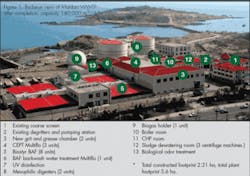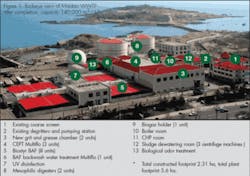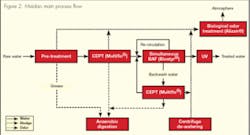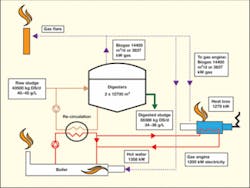A holistic approach to odor control
By Xuda Huang, Lin Wang, Remmi Thelisson, Weiyan Wang and Mark Elliot
The performance of municipal wastewater treatment with compact and advanced treatment processes — a case study of the Maidao WWTP in Qingdao, China
The original Maidao Wastewater Treatment Plant (WWTP) was equipped only with coarse screening, a grit removal unit and lift pumping station for deep sea discharge. To comply with new Chinese requirements regarding a “Discharge standard of pollutants for municipal wastewater treatment plants” (GB 18918-2002) and to organize the Beijing 2008 Olympic venue in Qingdao, the WWTP had to be upgraded. The main constraint was due to the increase in the hydraulic capacity from 100,000 m3/d to 140,000 m3/d over a very limited footprint area. In addition, the plant is located on the coast near the Olympic sailing area where high real estate values prevail. Therefeore, the final proposal selected was based on a compact plant needing as less as 2.5 times the footprint area compared to conventional activated sludge process. To comply with the neighborhood, plant design and architectural features were integrated, along with complete odor control. Sludge is digested and produced biogas is captured and used by a combined heat and power (CHP) system for energy recovery, thus optimizing power consumption. Figure 1 presents a picture of the built plant.
Main Process Description
To achieve the construction of the plant, compact processes were selected. For the primary treatment, a lamella settler, which combined with chemical enhanced primary treatment (CEPT) for precipitation, is a very reliable solution for solids removal. The secondary biological treatment is achieved with a set of biological aerated filters (BAF). The following sections present a description of all the solutions proposed for the extension of the Maidao WWTP. A general process description is illustrated in Figure 2.
For water and sludge treatment design purposes, the nominal daily flow to be treated is 140,000 m3/d with a peak flow of 7,583 m3/h. Table 1 presents the main characteristics of the water and sludge parameters.
Grit and Grease Removal
To remove the grit and grease from the raw water, two parallel grit and grease removal units were designed and built. Ten fine bubble turbine aerators were installed alongside a wall of the tanks for grease removal. Extracted grit is pumped to a classifier before storage in a bin while extracted grease is pumped to the anaerobic digesters. Experiences showed that sending grease to digesters is beneficial for the digestion process as it contains high volatile suspended solids (VSS) concentration.
Solids Reduction
In municipal wastewater applications, CEPT is an effective method to decrease solids load before downstream biological treatment, re- ducing the nutrient concentration and improving treatment efficiency. Located after the grease and grit removal systems, the CEPT was installed to remove most particulate pollutants (suspended solids, particulate BOD and phosphorus).
For this project, Veolia’s Multiflo® process was chosen. It’s a lamella settler unit with coagulation, flocculation and sludge thickening areas. This solution was selected for the high solids removal efficiency and its compactness.
Hydrogen Sulfide
To remove hydrogen sulphide (H2S) in the raw water, ferric chloride (FeCl3) is added. As the sludge is digested, the method used to remove H2S avoids installation of a dedicated biogas desulphurization unit. FeCl3 reacts with H2S to form FeS that precipitates and goes to the sludge: 2 Fe+ + 3 S2-→2 FeS↓ + S . The addition of ferric chloride used as coagulant for the CEPT provided a beneficial side-effect of H2S removal.
Operational Results
The performance of CEPT lamellar settler during July and August 2006 operation is summarized in Table 2, showing that Multiflo achieved high removal efficiency. Sludge concentration ranged from 42 g/L to 55 g/L with an average concentration around 53 g/L, suggesting that special dedicated thickener isn’t necessary when the Multiflo process is installed.
Nitrification/Denitrification
Biological aerated filtration (BAF) is an alternative to the traditional activated sludge process commonly used in biological wastewater treatment. Veolia’s Biostyr process is an up-flow BAF system using a submerged and floating fine granular polystyrene media. For the Maidao project, the optimum media diameter was 4.0 mm. Developed biomass and filtrated suspended solids will gradually fill the interstitial spaces and build up headloss, thus improving the filtration effect along the backwash interval. Periodic backwashes are triggered to remove excess biomass and captured solids from the filter bed.
In Maidao, this BAF process is operated in secondary simultaneous nitrification/Denitrification (N/DN) mode to perform partial denitrification in addition to COD, BOD5, TSS removal and nitrification. The principle design is doing nitrified water recirculation. The simultaneous N/DN mode is based on control of the aeration leading to less penetration of oxygen within the biofilm. The control is based on the influent and effluent ammonia loads, and the effluent oxygen concentration.
Periodic backwash wastewater is temporarily discharged into a surge tank before being treated by a dedicated lamella settler. The treated backwash wastewater is sent back to the BAF system blended with primary effluent. The control philosophy of the simultaneous N/DN is based on measurement of ammonia and dissolved oxygen (DO) to estimate the oxygen demand in order to supply the air needed for the process. Combined with the high oxygen transfer efficiency of the Biostyr system, this air supply control leads an energy saving between 20% and 30% compared to other total nitrogen removal BAF system. In Maidao WWTP, eight Biostyr cells of 231 m2 each, the largest such unit, were constructed with polystyrene beads of 4.0 mm diameter and 3.5 m media height.
TN Removal Performance
Although total nitrogen (TN) isn’t required by the discharge standard, simultaneous N/DN behavior has been investigated. The average TN removal rate of 27% is achieved. Considering the bio-sorption of TN by the biomass of 8-10%, the simultaneously denitrification efficiency is assumed varying between 17% and 20%, implying a saving of 17~20 % electric energy in aeration. Table 4 summarizes the overall performance on water treatment line, providing analysis from July to December 2007.
Sludge Digestion & CHP
At the Maidao WWTP, two units of one-stage digesters, with a volume of 12,700 m3 each, were constructed to treat 43,500 kg of dry sludge per day. A minimum retention time of 20 days is provided to assure proper sludge digestion. The diagram in Figure 3 shows the operation mode with cogeneration, or CHP. This is an ideal mode when the system is operated normally.
At the beginning, digesters were heated by boilers directly fed with biogas and, while the co-generators were started, recovered hot water was used to heat the digesters. As H2S concentration was very low (less than 10 ppm), co-generators were fed with high quality biogas.
The cogeneration system including four CHP systems were put into operation since the beginning of 2008 after having received approval of the local power authority for electrical network connection. The efficiency of the CHP system can be estimated in the following way:
Out of total biogas power, roughly a third of energy is transformed into electric power; a third of energy is recovered in the form of hot water (from cooling water and exhaust flue gas recovery) and the rest is lost in the flue gas.
After a few weeks’ commissioning, the CHP systems were producing a total electric power of 1,200 kW (with three units in operation and one in standby), covering over 50% of the electric power needs of the WWTP. Meanwhile, the recovered hot water is providing sufficient thermal energy to heat digesters.
Dewatering & Odor Removal
Digested sludge is sent to three centrifuge dewatering machines. The average dryness is 37.2 %.
Each treatment work is ventilated with an appropriate renewal rate to maintain good condition for the operators. The collected odor is treated with a biological deodorization process (Alizair®) from Veolia that involves biological oxidation of odorous compounds in a liquid phase. The principle of the process is bio-filtration. Use of mineral filtration media allows a design velocity as high as 500 m/h while using organic media like peat, the velocity is only 100 m/h. The three bio-filters of 67.5 m2 cross sectional area each and 1.0 m media depth were built to treat a total air flow of 100,000 m3/h. According to the deodorization commissioning record from April 18 to June 27, 2007, the Alizair process had a very good performance in NH3 and H2S removal. The concentration of inlet NH3 varied between 0.14 mg/L to 0.80 mg/L with an average of 0.28 mg/L, while NH3 was less than 0.08 mg/L at the outlet with the average removal rate of 82%.
The inlet H2S concentration had a large fluctuation from 0.1 mg/L to 1.12 mg/L, whereas H2S was less than 0.08 mg/L at the outlet with an average removal rate of 95%. These results indicate that inlet H2S concentration of the odor is low, implying the effect of FeCl3 dosing on H2S release.
Conclusions
Some strong points on Maidao WWTP’s successful case can be revealed:
- Compact treatment process is a good alternative for China where cities are often densely populated and land is limited.
- The treatment system exhibited high removal efficiency on organic and nutrient removal complying with the discharge standard.
- Some important innovations were achieved:
- Grease from pretreatment can be digested. A grease removal step in raw water seems impor-tant to protect downstream equipment. This is very often neglected by Chinese design institutes
- World’s largest unit size BAF (231 m2) was applied for the first time without having water and air distribution problems.
- CEPT produces a good effect on H2S reduction in produced biogas. A substantial capital and operational expense (CAPEX and OPEX) are saved on desulphurization. The CEPT may have contributed to low H2S in odor flow giving biological deodorization system more efficient.
- Cogeneration system producing more than 50% of the electricity needed for the plant operation. Even considering operation and maintenance costs, OPEX is greatly reduced. Cogeneration is indeed a good example of green house gas effect reduction and commitment to the sustainable development.
Author’s Note:
Xuda Huang and Lin Wang are with the College of Environment Science and Engineering at Ocean University in Qingdao, China. Contact: www.ouc.edu.cn. Remi Thelisson, Weiyan Wang and Mark Elliott are with Veolia Water Solutions & Technologies (Beijing) Co. Ltd. in Beijing, China. Contact: www.veoliawaterst.com







